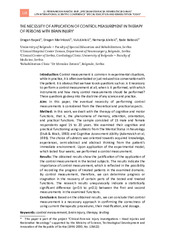Приказ основних података о документу
The Necessity of Application of Control Measurement in Therapy of Persons with Brain Injury
| dc.creator | Rapaić, Dragan | |
| dc.creator | Marinković, Dragan | |
| dc.creator | Aleksić, Vuk | |
| dc.creator | Aleksić, Nemanja | |
| dc.creator | Babović, Rade | |
| dc.date.accessioned | 2024-01-10T13:42:16Z | |
| dc.date.available | 2024-01-10T13:42:16Z | |
| dc.date.issued | 2023 | |
| dc.identifier.isbn | 978-86-6203-168-6 | |
| dc.identifier.uri | http://rfasper.fasper.bg.ac.rs/handle/123456789/5355 | |
| dc.description.abstract | Introduction. Control measurement is common in experimental situations, while in practice it is often overlooked or just reduced to a conversation with the patient. It is obvious that we have to ask questions such as: is it necessary to perform a control measurement at all, when is it performed, with which instruments and how many control measurements should be performed? These questions go deep into the doctrine of any science and practice. Aim. In this paper, the eventual necessity of performing control measurements is considered from the theoretical and practical aspects. Methods. In this work, we dealt with the therapy of cognitive and motor functions, that is, the phenomena of memory, attention, orientation and practical functions. The sample consisted of 15 male and female respondents aged 15 to 20 years. We examined their cognitive and practical functioning using subtests from The Mental Status in Neurology (Strub, R., Black, W. 1983) and Cognitive Assessment Ability (Adamovich, B., Henderson, J., Auerbach, S., 1985). The choice of subtests was oriented towards acquired knowledge, experiences, semi-abstract and abstract thinking from the patient's immediate environment. Upon application of the experimental model, which lasted four weeks, we performed a control measurement. Results. The obtained results show the justification of the application of the control measurement in the tested subjects. The results indicate the importance of control measurement, which is reflected in the possibility of recording the progress of treated patients in the examined domains. By control measurement, therefore, we can determine progress or stagnation in the recovery of certain parts of the tested and treated functions. The research results unequivocally indicate a statistically significant difference (p<0.5 to p<0.1) between the first and second measurements in the examined functions. Conclusion. Based on the obtained results, we can conclude that control measurement is a necessary approach in confirming the correctness of using current therapeutic procedures, their modification and dosage. | sr |
| dc.language.iso | sr | sr |
| dc.language.iso | en | sr |
| dc.publisher | Univerzitet u Beogradu - Fakultet za specijalnu edukaciju i rehabilitaciju | sr |
| dc.relation | info:eu-repo/grantAgreement/MESTD/Basic Research (BR or ON)/175083/RS// | sr |
| dc.rights | openAccess | sr |
| dc.rights.uri | https://creativecommons.org/licenses/by/4.0/ | |
| dc.source | Zbornik rezimea / 12. međunarodni naučni skup Specijalna edukacija i rehabilitacija danas, | sr |
| dc.subject | control measurement | sr |
| dc.subject | brain injury | sr |
| dc.subject | therapy | sr |
| dc.subject | testing | sr |
| dc.title | The Necessity of Application of Control Measurement in Therapy of Persons with Brain Injury | sr |
| dc.type | conferenceObject | sr |
| dc.rights.license | BY | sr |
| dc.citation.epage | 118 | |
| dc.citation.spage | 117 | |
| dc.identifier.fulltext | http://rfasper.fasper.bg.ac.rs/bitstream/id/10877/bitstream_10877.pdf | |
| dc.identifier.rcub | https://hdl.handle.net/21.15107/rcub_rfasper_5355 | |
| dc.type.version | publishedVersion | sr |


